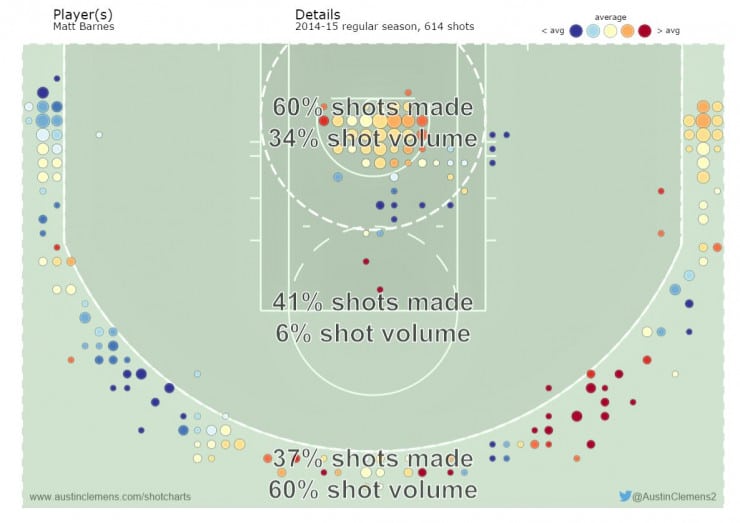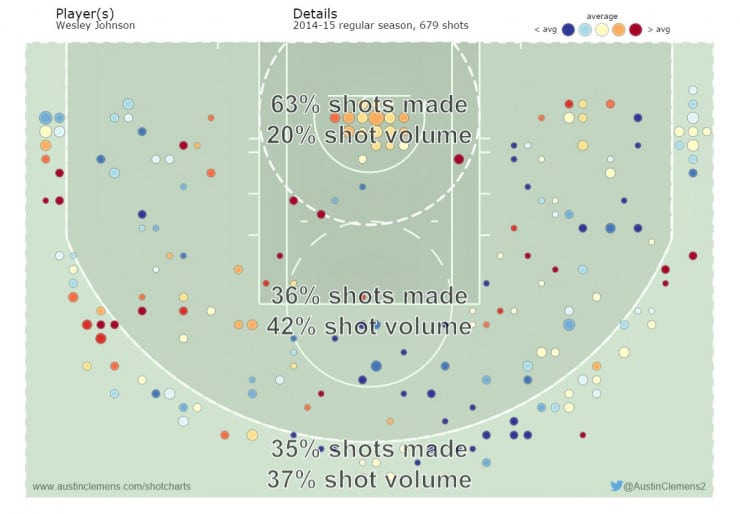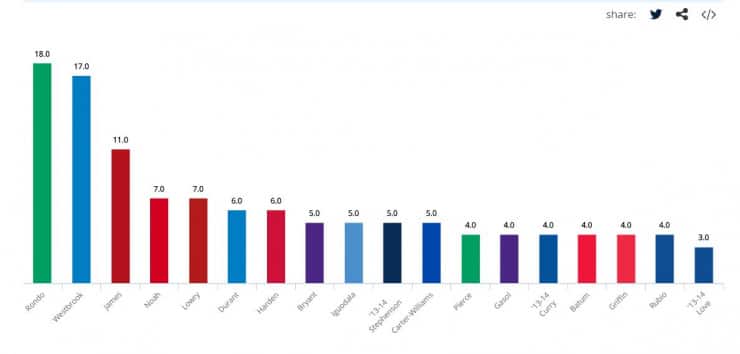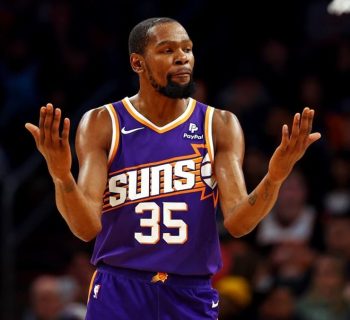NBA
NBA PM: Making Sense of the Lance Stephenson Trade

On Monday, the Los Angeles Clippers agreed to trade Matt Barnes and Spencer Hawes to the Charlotte Hornets in exchange for Lance Stephenson. It was a trade that included two of the more disappointing free agent signings from last summer.
After playing at a borderline All-Star level in 2013-14 with the Indiana Pacers, Stephenson signed with the Charlotte Hornets to help them take the next step in their development. In Stephenson, the Hornets were adding a 24-year-old swingman who could handle the ball and play stingy defense. The biggest concern with Stephenson is the fact that he is a hard personality to deal with. He has been described as “temperamental” and has had numerous on-court issues in the past. It was a worthwhile gamble at the time for the Hornets, even though the relationship ultimately didn’t work out.
For the Clippers, in trading for Stephenson they are taking the same sort of gamble that the Hornets took last offseason, only this time there are even more concerns. In his final season with the Indiana Pacers, Stephenson averaged 13.8 points, 4.5 assists and 7.2 rebounds per game, while shooting 49.1 percent from the field and 35.2 percent beyond-the-arc. He was a versatile two-way player that showed a developing game. However, in his one season with the Hornets, Stephenson averaged just 8.2 points, 3.9 assists and 4.5 rebounds, while shooting 37.6 percent from the field and 17.1 percent from three-point range.
There were a lot of factors that went into Stephenson’s drop-off. Entering the season he injured his groin, and never fit within the Hornet’s offensive schemes. He couldn’t knock down three-pointers* and his inability to consistently hit shots off the dribble made it difficult to play him heavy minutes.
So why would Doc Rivers, the Clippers head coach and team president, swing a trade for Stephenson after his steep decline?
First, the Clippers have been looking for young, athletic and productive wing players for several years now. Relying on J.J. Redick, Jamal Crawford, Austin Rivers and Matt Barnes was not a tenable situation if the Clippers want to make a deeper playoff run next season. Los Angeles has gotten by with Matt Barnes as their starting small forward for three years now, but he is now 35 years old and could see a major decline moving forward.
However, it should be noted that the Clippers didn’t give up nothing for Stephenson. As bad as Hawes was in his one and only season with the Clippers, there was reason to believe he could bounce back next season. At his best, Hawes could have been the Clippers’ third big (assuming they successfully re-sign DeAndre Jordan this offseason), and could provide spacing as a stretch-4 with his shooting. And as much criticism as Barnes received, he was in many ways exactly what the Clippers needed at small forward in the starting lineup.
Consider that last season, the Clippers’ starting lineup was one of the best in the NBA:
Chart Courtesy of NBA.com/stats
As we can see in this chart, the Clippers’ starting unit was the most efficient offensive lineup in the NBA and had a top three net differential (among all lineups that played 300 minutes or more together throughout the regular season). The Clippers couldn’t have managed this if Barnes was a complete stiff, as some people have characterized him. Barnes was able to do this with above average perimeter defense, timely cuts to the basket, easy baskets in transition and by knocking down catch and shoot three-pointers.
As we can see from the chart above, Barnes made a living with three-pointers and shots at the basket. While it’s not particularly easy to find a competent 3-and-D wing player to fill this role, it still is a role that can be addressed with minimal financial flexibility.
The Clippers have reportedly shown interest in Wesley Johnson, who played with the Los Angeles Lakers this past season. Johnson has never lived up to the expectations that came with being selected fourth overall in the 2010 NBA Draft (one pick ahead of DeMarcus Cousins), but at the league-minimum, he has value. He may not be a lock-down defender, but he has the size, length and athleticism to be competitive. And on offense, he has shown that he could potentially take over Barnes’ role on offense.
Shot Charts Courtesy of www.austinclemens.com/shotcharts/
As we see here, Johnson shot pretty well from three-point range this last season, almost as good as Barnes. The difference is that in Byron Scott’s offense (which features a heavy dose of mid-range jumpers), Johnson was shooting the ball from all over the court. This is contrary to the modern approach with players like Johnson, who are often positioned to take open, set jumpers, and attack the rim against rotating defenses.
Put Johnson in Barnes’ role, and we could see his shooting percentages climb and overall efficiency increase. If that happened, suddenly that potent offensive unit the Clippers had with Barnes could remain somewhat intact. Another positive in adding Johnson is the fact that he’s still just 27 years old, so there is room for him to continue improving. That, and he would move from an offense that was being run by Jeremy Lin, Jordan Clarkson and Ronnie Price, to an offense run by Paul and Griffin, who are both able to consistently generate open looks for teammates. The fact that Johnson had a 52.7 effective field goal percentage* on spot up jumpers last season (74.6 percentile), whereas Barnes had a 51.5 effective field goal percentage (64.8 percentile) provides more reason to believe he could be a competent replacement for Barnes.
Of course, we never know how effective a player will be with a new team in a new system until the players take the court. It’s also unclear whether a player like Johnson (who will certainly be looking for a multi-year deal) would be open to a veteran’s minimum contract at this point in his career. But Johnson is simply representative of the sort of player the Clippers could target to take over for Barnes.
Another such option, as discussed by our Alex Kennedy and Moke Hamilton on Tuesday’s Insider Sports Podcast, could be adding Paul Pierce with the mini mid-level exception (if he opts out of his deal with the Washington Wizards). In that scenario, the small forward role would need to be redefined in the Clippers’ offense since Pierce is more than a spot up three-point shooter.
The main point here is that the starting small forward position can be filled with a competent player, which allows Stephenson to take a lead role in the second unit, which Rivers alluded to in his interview on Tuesday with Fred Roggin on the Beast 980 AM in Los Angeles.
In the playoffs, the Clippers relied on Austin Rivers and Jamal Crawford to be the primary ball-handlers off the bench. While Rivers had impressive spurts throughout the postseason, it is less than ideal to peg him as the lead guard off the bench moving forward. This is where Stephenson comes in.
Part of Stephenson’s struggles last season came from the fact that he was sharing the court with Kemba Walker, a ball-dominant, scoring point guard. In the Clippers’ second unit, he won’t have to share the ball with Chris Paul and can facilitate the offense as the primary playmaker.
How Stephenson fits is anyone’s guess since Rivers said he will play anything from point guard, to shooting guard, to small forward for the Clippers. But considering how successful Stephenson was with a playmaking role in Indiana, how ineffective he was playing off the ball with Walker, and his spotty three-point shooting, the smart money is on Stephenson running the offense a lot when Paul is resting. His creativity off the dribble and large frame gives the Clippers an offensive weapon that was missing this last season, which in part explains why the Clippers’ bench was so ineffective.
In addition to being the lead guard off the bench, Stephenson also gives the Clippers a viable defensive option against the league’s best perimeter scorers. Barnes has been the Clippers best and only option against players like Kevin Durant, LeBron James, Carmelo Anthony, Kawhi Leonard and Jimmy Butler, which is less than ideal to say the least.
“We needed to get tougher and we needed to get more athleticism and we needed to improve defensively,” Rivers told Roggin. “Lance has shown he can do that for us. … He’s a tough kid, very competitive kid and that has gotten him in trouble at times, but the one thing he has shown in major playoff games is that he can be a top-tier defender.”
Barnes was scrappy and always put up a good effort, but he has lost a step in recent seasons and couldn’t offer the defensive presence that guys like Leonard, Butler and Stephenson can. This is one of the main reasons Hornets owner Michael Jordan signed Stephenson last offseason.
“One of the reasons why I admire his game is he takes on challenges,” Jordan said last October. “For us to get any place in the East, we need someone to challenge LeBron. He challenged LeBron.”
If the Clippers plan on making it to the NBA Finals next season, having someone like Stephenson, who isn’t afraid of going toe-to-toe with an opponent as dominant as James, could be key. No one really stops a player like James, but standing 6’5 with a 6’10 wingspan, Stephenson has as good of a chance as some of the better defenders in the league and certainly a better chance than Barnes.
Also, the Clippers simply need more talent. The Western Conference doesn’t figure to be any easier next season, so the chance to add a player as versatile as Stephenson on a team-friendly contract was a unique opportunity that Rivers couldn’t pass up.
“The team that gets the best player in the trade gets the best trade,” Rivers said. “And in this case, I think Lance is the best player in this trade.”
Stephenson was so bad in his one season in Charlotte that we forget just how good he can be when he is focused and in the right environment.
Graph Courtesy of www.statmuse.com/nba
As illustrated in the graph above, over the last five seasons, Stephenson is in a four-way tie for the sixth most regular season triple doubles, all of which came in 2013-14. To add a player capable of that, before he enters his prime, is a pretty solid addition (albeit risky in the case of Stephenson because of chemistry concerns), especially when you consider his contract.
“If Lance works out, great,” Rivers said. “If he doesn’t, it’s a one-year deal. I just like contractually where it went for us.”
In making this trade, the Clippers get out from under Hawes’ contract, which has him earning roughly $18.5 million over the next three seasons. With Stephenson, the Clippers have a team option for 2015-16, which they can decline if he doesn’t fit well with the team. And by having that option, the Clippers can also move Stephenson mid-season to a team that is looking to offload more salary heading into the 2016 free agency season.
Rivers is certainly responsible for putting the Clippers’ in a position where this sort of high-risk, high-reward move is their only real option for improving. However, this deal is certainly a creative improvement over sending away a competent wing player and a first-round draft pick just to offload salary and avoid the apron (which is what Rivers did with Jared Dudley). In this move, Rivers lands a player that fills a big need, while adding financial flexibility. There is reason to be skeptical, or flat out critical of this trade, but this is a step in the right direction for Rivers as a general manager.
This deal wouldn’t have been made if Rivers wasn’t confident he can help Stephenson find his old game. Rivers has been an expert at managing personalities throughout his coaching career (see Rajon Rondo), though Stephenson may be his biggest challenge yet.
In eight months, we may be looking at this deal as a coup or a disaster for the Clippers. But at this moment, with little financial flexibility, an aging Chris Paul and a roster in need of more talent, it is the sort of high-upside deal the Clippers needed to make.

















